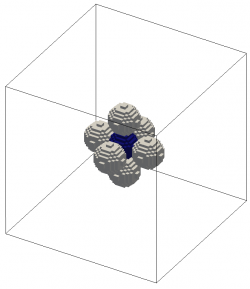-
Notifications
You must be signed in to change notification settings - Fork 115
Atlas generation using elastix
This page describes the use of elastix and transformix to generate an average dataset, called an atlas.
A synthetic population dataset is used to demonstrate the registration approach, which is based on the work by Van Hecke et al. [1] and Seghers et al. [2].
- Given a population of scalar volumes, compute the average dataset or atlas.
- Subject-based: select one reference that is deformed towards the average.
Other subjects will be registered to the reference, and subsequently deformed towards the average.
Perform a voxel-wise average of the results to account for small differences. - Population-based: deform each subject towards the average and perform a voxel-wise average of the results to account for small differences.
- Subject-based: select one reference that is deformed towards the average.
Note 1: As stated in the elastix manual (Chapter 2.1), a registration from the moving to the fixed image involves a mapping from the fixed to the moving image.
This is essential for the understanding of the atlas generation example.
Note 2: Instead of using the mean of the inverse transformations, as described by Van Hecke et al. [1], we compute the inverse of the mean (forward) transformation.
A (Windows) PC with the elastix and Python binaries.
The Python script relies on some external libraries, mainly NumPy and SimpleITK.
The demo will run without SimpleITK, but the final voxel-wise average will not be performed.
The synthetic data consists of six scalar (binary) volumes, each containing a sphere. Each volume contains 643 voxels of size 1 mm3 with an identity basis. The data is contained in the demonstration package.

The white spheres are contained in the population data set. The blue sphere represents the generated average, or atlas, sphere.
-
elastixversion: v4.6 - Python: v2.7
- SimpleITK: v0.6.1 (optional)
Parameter files:
Demonstration scripts:
- atlas_register-population-spheres-demo.py
- atlas_register-subject-spheres-demo.py
- sphere data to be found in images/atlas when cloning the wiki
Command line call for Python script - subject-based registration:
python atlas-register-subject-spheres-demo.pyCommand line call for Python script - population-based registration:
python atlas-register-population-spheres-demo.py-
W. Van Hecke, J. Sijbers, E. D'Agostino, F. Maes, S. De Backer, E. Vandervliet, P. M. Parizel, and A. Leemans. On the construction of an inter-subject diffusion tensor magnetic resonance atlas of the healthy human brain. NeuroImage, vol. 43, no. 1, pp. 69-80, Oct. 2008.
-
D. Seghers, E. D'Agostino, F. Maes, D. Vandermeulen, and P. Suetens. Construction of a brain template from MR images using state-of-the-art registration and segmentation techniques. In Proc Intl Conf Med Image Comput Comp Ass Interv, pp 696-703. 2004.